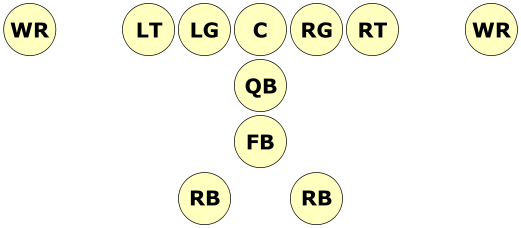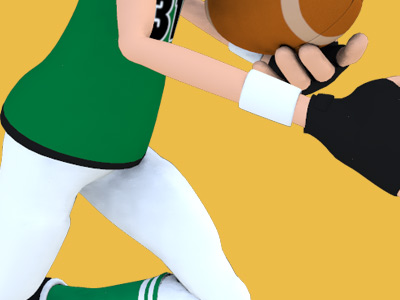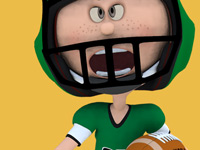American football

Wishbone formation (American Football Strategy)
The wishbone formation, also known simply as the ’bone, is an offensive formation in American football. The style of attack to which it gives rise is known as the wishbone offense. Like the spread offense in the 2000s, the wishbone was considered to be the most productive and innovative offensive scheme in college football during the 1970s and 1980s.

A variant of the wishbone formation with two wide receivers (WR). The basic wishbone has one tight end and one wide receiver
Athletes required
The Oklahoma playbook describes the quarterback, the architect behind the Wishbone, as, "a running back who can throw." They must also have an aptitude for the option and the decision making that lies within the play design as well as durability (cannot miss a practice).
The fullback is required to be able to handle a physical pounding because he is frequently hit without having the ball; he must also be quick with excellent stamina, and be a good blocker.
Running the 'Bone
The wishbone was designed to run a triple-option with a lead blocker. The purpose of an option is to eliminate one defender without blocking him. Ideally, the defender must make a choice to eliminate one of two offensive players. This is a double option. This option offensive scheme forces a defender to choose one of two offensive players who can advance the ball and then allows the other offensive player to carry the ball, making whatever choice the defender made the "wrong" choice. Because of this aspect of the defensive player taking himself out of the play by his choice, the offensive player that would otherwise block that defensive player can now block a different defender, placing severe pressure on the defense to cover the dive, the quarterback run, the pitch or the pass to a receiver.
The triple-option, then, eliminates two defenders without blocking them. This frees two offensive linemen to block different defenders, usually inside defenders. This isolates the dive key and the pitch key for the QB to "read" and should leave only an outside support defender (usually a safety) and the cornerback to cover the End, who is running a deep pass route. As Pepper Rodgers and Homer Smith stated in "Installing Football's Wishbone T Offense", "To run a Triple Option with a lead blocker is the reason for the Wishbone formation." It is the "extra blocker" concept that drives the success of the wishbone and its derivatives. The cornerback must cover the outside receiver. The support/safety must support the run defense and (usually) covers the pitch back. The defensive end typically attacks the quarterback and a defensive tackle is assigned the fullback dive. These assignments must be made before the play begins and that totals eight defensive players to both sides of the ball.
As stated above, however, the offense now has linemen that can be released to block other defenders, usually inside. The play is designed to handle five defenders on either side of the ball. Thus, the defender least able to affect the play, the offside cornerback or deep safety, is not blocked by design. The offensive linemen, now free to block inside, can block the first down lineman to the playside and the first linebacker to the playside. Emory Bellard once said, "If the threat of the fullback can be applied to the defense, the offense is sound." Then, the lead back principle takes over. The lead back can block the defensive end or the safety and there is then a one-on-none possibility for the offensive player with the ball. In order to stop this attack, the defense must defeat blocks or flow defenders to the playside.
This makes the wishbone a "complete" offense. The offense expects to get a one-on-none in the running game and a one-on-one in open space with the passing game. The safety, who must support the run and also defend against the pass, is under tremendous pressure in this attack. The basic wishbone triple option play accounts for every defender on the field. Every defender is threatened before the basic play begins. There is an invitation to overplay or compensate on the basic play and overplaying or making a misstep on the basic play leaves the defense open for counters that leave no one to make up for the mistake.
The wishbone has the quarterback taking the snap from under center, with a fullback close behind him, and two halfbacks (sometimes called tailbacks) further back, one slightly to the left, and the other slightly to the right. The alignment of the four backs makes an inverted Y, or “wishbone”, shape. There is typically one wide receiver and one tight end, but sometimes two wide receivers, or two tight ends.
The wishbone was designed to facilitate a running, option offense. It allows the quarterback to easily run the triple option to either side of the line. The quarterback first reads the defensive tackle or linebacker who is unblocked. As he reads the tackle/linebacker, he rides the ball in the fullback's gut. If the defensive tackle/linebacker looks to tackle the fullback the quarterback pulls the ball out and runs down the line to his next option read, usually the defensive end/outside linebacker. If the end/linebacker looks to tackle the quarterback, the ball is pitched to the trailing halfback. The lead halfback is a lead blocker usually looking to block the outside defensive player, a safety or corner. The tight end to the option side 'arc' releases to block the safety.
SPORTS



American Football
Game play in American football consists of a series of downs, individual plays of short duration, outside of which the ball is dead or not in play. These can be plays from scrimmage – passes, runs, punts, or field goal attempts (from either a place kick or a drop kick) – or free kicks such as kickoffs and fair catch kicks. Substitutions can be made between downs, which allows for a great deal of specialization as coaches choose the players best suited for each particular situation. During a play, each team should have no more than 11 players on the field, and each of them has specific tasks assigned for that specific play.
Rules and gameplay
- Scoring
- Maneuvers
- Strategy
- Play types
- Penalties
- Turnovers
- Downs
- Teams and positions
- Field
- Equipment
- Duration and time stoppages
- Advancing the ball and downs
- Kicking
- Officials and fouls
Positions
Offensive (Interior) line
Backs and receivers
Defensive line
Linebackers
Defensive backs
Special teams
- Kicker (K)
- Holder (H)
- Long snapper (LS)
- Punter (P)
- Kickoff specialist (KOS)
- Kick returner (KR) and Punt returner (PR)
- Upback
- Gunner
- Jammer


RESOURCES
This article uses material from the Wikipedia articles "American football", "American football rules", "Strategy", "Wishbone formation", which is released under the Creative Commons Attribution-Share-Alike License 3.0.
© Stories Preschool. All Rights Reserved.





